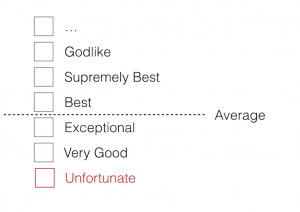 At school (at least in the US), we are taught to aim for 100 out of 100. It seems that grade inflation has made a perfect score far too attainable. It’s a phenomenon that is rife at all higher institutions, including the upper crust schools. In fact, it was reported by The Crimson last year that, at Harvard, the mean grade point average is 3.64 (just below an A-). Aside from suggesting that we’re perfect and totally equipped for life, such grades implicitly reinforce a search for perfection. In a world where we are programmed to seek perfection, the ability to critique and criticize becomes all the more strategic. Certainly, to aim for 100% is necessary in certain disciplines. For example, you can’t afford to screw up in:
At school (at least in the US), we are taught to aim for 100 out of 100. It seems that grade inflation has made a perfect score far too attainable. It’s a phenomenon that is rife at all higher institutions, including the upper crust schools. In fact, it was reported by The Crimson last year that, at Harvard, the mean grade point average is 3.64 (just below an A-). Aside from suggesting that we’re perfect and totally equipped for life, such grades implicitly reinforce a search for perfection. In a world where we are programmed to seek perfection, the ability to critique and criticize becomes all the more strategic. Certainly, to aim for 100% is necessary in certain disciplines. For example, you can’t afford to screw up in:
- Baby food
- Infrastructure engineering
- Manufacturing safety
- Cyber security
- Manned space rockets
- High wire act without a net
- …
Errors will still be made, but they are massively costly. Perfection — as in 100 out of 100 — is the right objective. But, this is not true of all business.
To aim for 100% can be desirable
At another level, there are other domains where it is entirely desirable to aim for 100% — including customer service, customer satisfaction, computer programming, factory forecasts and innovation — but, it’s never really achievable. And, for the most part, it is really much more powerful to give 100% rather than to attain 100%. In the former, you are providing effort, intending to be best. It’s the effort and the journey toward the goal that is important and provides the highest value. As George Fisher is quoted as saying:
'When you aim for perfection, you find that it's a moving target.' - George Fisher Share on X
Staying at 100%
Getting to the top is one thing; staying at the top takes another level of sustained energy. Taking the position of underdog is a natural motivator (one of the forces that rode Apple to the top). But, how to maintain the collective energy at the highest possible run rate? Staying at the top takes accepting -- indeed encouraging and embracing -- imperfection and risk-taking. Share on X Let’s call it the Marilyn Monroe mole. When looked at as part of the whole, the mole takes on a total charm. As Arianna Huffington is presciently quoted as saying:
'Failure is not the opposite of success. It's part of success.' - Arianna Huffington Share on X
What narrative for imperfection?

To the extent mistakes are costly and can certainly lead to out-and-out failure, the challenge is finding a sustainable model of success. If innovation is the lifeblood of most businesses, there is no innovation without risk and a healthy dose of failures. Back in the 1970s in Britain, at secondary school, I was brought up with a grading system that said that an A (the best grade) was around a 65%. As a result, I always knew I could do better. I think this is a much more salubrious way to mark your work. We should always strive to do better. It is complacency and the sense of self-satisfaction that are anachronous with the spirit of innovation. Somewhere in the deeper human consciousness, we all are attracted to imperfections. It is more important to learn to accept one's weaknesses than to strive eternally for perfection. Share on X
As Seth Godin wrote in this post, entitled Waiting for Perfect, “You’ve permitted magical to walk on by. Not to mention good enough, amazing and wonderful. Waiting for the thing that cannot be improved (and cannot be criticized) keeps us from beginning. Merely begin.”
For leaders, it’s about instilling an ongoing desire to do better, to attempt the unattempted, and to learn from one’s mistakes. One of the strongest ways to instill such a culture is to have a strong overriding mission. The effort and results serve a higher purpose to which individual position is subordinate. Moreover, rather than aiming for Mr Perfect, I might suggest aiming to be messy, scrappy and real.
Your thoughts and reactions?











